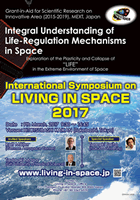NEWS & TOPICS
- 16 Feb 2021
- The research group led by Prof. Naruse (A01), Okayama University Graduate School of Medicine, Dentistry and Pharmaceutical Sciences, had developed a fluorescence microscope system that generates hypergravity by centrifugal force and have succeeded to get image changes in cell morphology under hypergravity by remotely controlling a CMOS camera and LED light source during rotation. In addition, the review article, "Gravity sensing in plant and animal cells" was published in NPJ Micrograivty at DOI: 10.1038/s41526-020-00130-8→ Link to article
- 28 Feb 2020
-
We have posted a summary of the open symposium scheduled to be held on Saturday, February 29, 2020.
We had decided to cancel this time, but we received many applications and it was a great encouragement for all the members, sincerely thank you for all applicants.
- 18 Feb 2020
-
[Important] Notice of cancellation of the open symposium science open space for "living in space"
Planned on February 29, 2020, following the WHO (World Health Organization) Declaration of "International Concerned Public Health Emergency" and the designation of "Designated Infectious Disease" by the Japanese government regarding the new coronavirus infection. We have decided to cancel the open symposium / science open space for the "Living in Space", a new academic area research funded by Kakenhi.
All the team members have been preparing for the event, but we are deeply sorry for the inconvenience caused to everyone who was looking forward to the event because we had to make a difficult decision in an emergency situation that exceeded our expectations. We apologize for the inconvenience.
Unfortunately, this time it will be canceled, but we will continue to disseminate information on the area on the "Living in Space" website, so if you are interested, please take a look.
- 18 Jun 2019
- The research team of Professor Atsushi Higashitani (A01), Graduate School of Life Sciences, Tohoku University, collaborated with Nottingham University and Exeter University in England, showed mitochondrial dysfunction causes calcium to build up in cells, which in turn activates enzymes that degrade collagen. Collagen is vital for giving structure to the outside of cells, so degradation of collagen destabilises muscle.
The article, "Mitochondrial dysfunction causes Ca2+ overload and ECM degradation-mediated muscle damage in C. elegans" was published online in The FASEB Journal.
- 15 Mar 2019
- The 2nd International Symposium on LIVING IN SPACE 2019 was held on March 15th, 2019 at Inamori-Hall, Shiran-Kaikan in Kyoto.
→Link to article
- 18 June 2018
- A research team of the International Institute for Integrative Sleep Medicine (WPI-IIIS) in Japan’s University of Tsukuba led by Prof. Liu and lead author Zhiqiang Wang that includes members of Living in space (A02), Prof. Yanagisawa and Visiting Prof. Funato, identified 80 proteins that are hyper-phosphorylated in both sleep-deprived and Sleepy mutant mouse brains, by analyzing the quantity of change in phosphorylation. The article, "Quantitative phosphoproteomic analysis of the molecular substrates of sleep need" was published online in Nature at DOI: 10.1038/s41586-018-0218-8.
→Link to article
- 15 Nov 2017
- Asako Sakaue-Sawano, a research member of Living in Space (B01) has successfully developed novel genetically encoded cell cycle optical sensor, Fucci(CA) in a collaborative project. As reported in Molecular Cell, November Issue, Fucci(CA) monitors cell-cycle interphase with boundaries between G1, S, and G2 phases in real-time. Fucci(CA)2 also identifies a window for UV irradiation damage in S phase on HeLa cells. This technology is expected to contribute to understand cell cycle behavior in "Living in Space".
→Link to article
- 13 June 2017
- A team led by Prof. Higashitani(A01), Tohoku University, revealed the mechanism of heat stress induced muscle breakdown in body-wall muscles of Caenorhabditis elegans exposed to elevated temperature. The findings are published in a prestigious academic journal, Genetics. The findings are expected to lead to prevention of heat stroke aggravation.
→Link to article
- 08 May 2017
- PATHWAY to convert visual information into the feeding motivation was identified in zebrafish; a team led by Prof. Kawakami and Dr. Muto, National Institute of Genetics, published an online article in Nature Communications dated Apr.20 reporting that the pretecto-hypothalamic pathway plays a crucial role in conveying visual information to the feeding centre. It is expected to control appetite in space in the future. →Link to article
- 21 Mar 2017
- Regenerated fibers lack hypertrophying function in skeletal muscle: A team led by Dr. Kawano of Matsumoto University published a research article titled" Prenatal myonuclei play a crucial role in skeletal muscle hypertrophy in rodents." in American ournal of Physiology Cell Physiology published in March 2017. →Link to article
- 03 Feb 2017
- A team led by Dr. Lazarus, University of Tsukuba, has discovered a direct link between REM sleep loss, the medial prefrontal cortex and the desire for sugary and fatty foods according to Asahi Shimbun →Link to Asahi Shimbun
- 24 Jan 2017
- A team led by Profs. Masashi Yanagisawa and Hiromasa Funato of WPI-IIIS, University of Tsukuba (Programmed Research Nagase Group) identified mutations that affect sleep/wakefulness in mice; amount of rapid eye movement (REM) sleep and non-REM sleep shown to be regulated by NALCN and SIK3 proteins, respectively. This landmark paper was published in Nature.→Link to article
- 17 Jan 2017
- Prof. Akira Kudo at Tokyo Tech, in collaboration with Dr. Chaya at Showa University, reported in Scientific Reports,nature-com published on December 22 that live-imaging and transcriptome analysis of medaka fish transgenic lines identified the immediate alteration of cells responsible for bone structure formation. These findings are important for assessing the effects microgravity on long term human space missions. →Tokyo Tech News


